THIS POST is part of a series describing the rule changes I’ve made for my current fantasy role-playing campaign. “Kilgore’s Dungeons & Dragons,” or “KD&D,” is a full-fledged variant of the 1st Edition Advanced Dungeons & Dragons game initially released in 1977. Feel free to use some or all of these rule changes for your own D&D gaming, no matter what edition you play.
AS I DESCRIBED in the inaugural post to this series, I’ve started playing 1e AD&D again, running a campaign for my neighbors and family. While I’ve always enjoyed AD&D, the game system itself can be clunky and difficult, and some parts are, frankly, lame.
To make what I consider to be improvements to the core rules, I’ve borrowed ideas from issues of Dragon magazine and later D&D editions, as well as come up with a few of my own. My operating motto for re-tooling the game is to make it, “Simpler & Better.”
In this post and the next one, I’d like to discuss creating characters. First up, let’s look at races, which, in AD&D, are covered in the Players Handbook (PHB), and in the supplement Unearthed Arcana (UA).
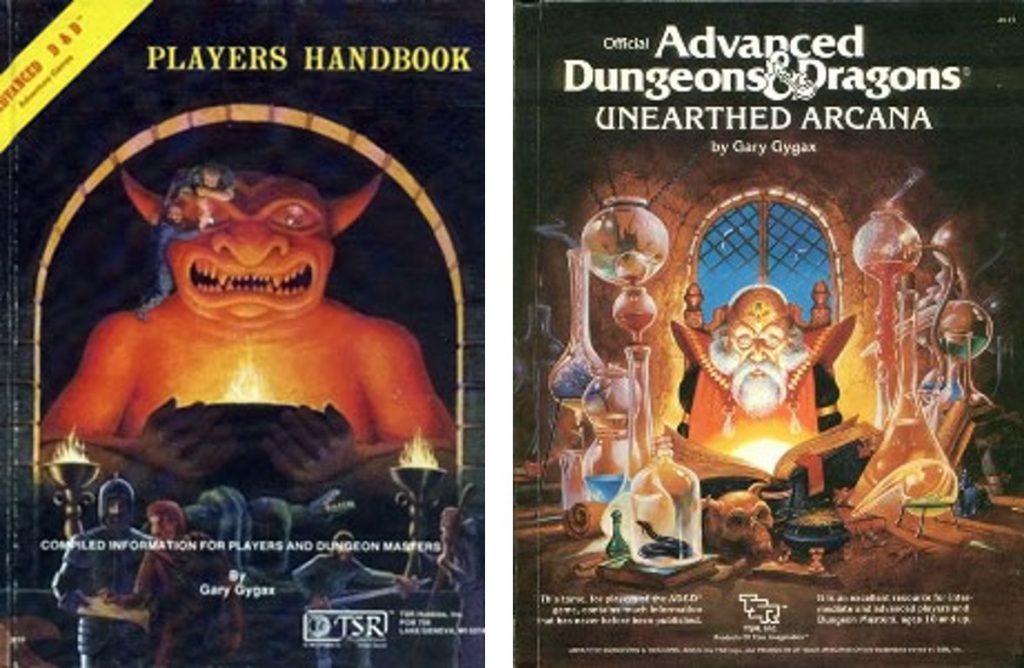
Player-Character Races
The PHB gave AD&D players the choices of humans, half-elves, high elves, wood elves, hill dwarves, gnomes, halflings, and half-orcs. UA added gray elves, wild elves, valley elves, dark elves, mountain dwarves, gray dwarves, and deep gnomes; it also had some stuff to flesh out the differences among the various types of halflings.
More about all those options in a bit, but for now, let me just say that in my new campaign, I’m keeping the races to:
- Humans
- Elves (High- or Wood-)
- Half-Elves
- Dwarves
- Gnomes
- Halflings
Let’s look at each of them, and the changes I made.
Humans
In 1e AD&D, humans have a lot going for them. They can be any character class, they have no level limits, and they enjoy (in UA) an exclusive and very generous method to generate their ability scores (for example, fighters can roll 9d6 for their Strength scores, keeping the highest three).
And yet, in my campaigns, humans were usually in the minority, because many players found them boring in comparison to the other races. Humans, I decided, needed some pizzazz.
To make playing a human more attractive, I cribbed an idea from somewhere (maybe the 3e PHB?) and ruled that humans learn skills very quickly. Any human character, regardless of class, gets a 10% bonus to experience points, which can be combined with the 10% bonus for exceptional abilities that some character classes have.
Now, there’s a really good reason to play a human instead of a demi-human. You won’t have infravision, or bonuses when fighting giants, or be better at moving silently when not in metal armor. But you’ll sure advance faster.
Similarly, humans start off at 1st level with the same number of non-weapon proficiencies as demi-humans do, but receive two non-weapon proficiencies instead of one when they attain more through gaining character class levels.

I’ve found that these boosts have made humans much more popular in my campaigns. Currently, we have four humans, a half-elf, an elf, and a dwarf. A very diverse bunch.
Elves
Player character elves have two huge problems.
The first is that they’re the golden children of the PHB, getting all the goodies: cool and very helpful special abilities, preferred weapons, and a wide range of class choices. Compared to them, other races are red-headed stepchildren.
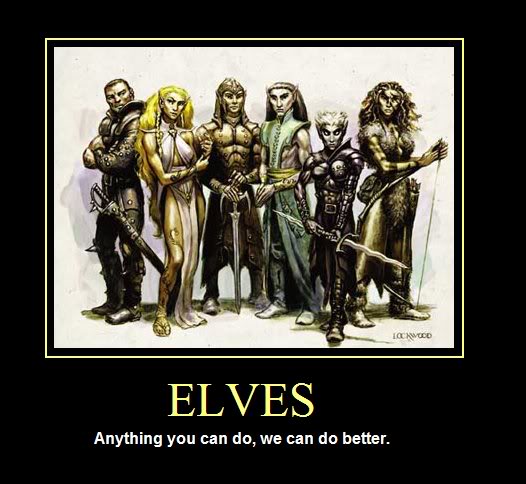
The second problem is that in UA, as I mentioned, their ranks swell unnecessarily and ridiculously. How many varieties of elf do you need to have in a game? Are there really that many differences between gray elves and high elves, or between wood elves and wild elves—and could anyone besides Robert De Niro portray those in a role-playing game? I think not.
And dark elves? They have lots of cool abilities, but how viable is it to play a character that’s allergic to something as basic as sunshine? And that all other elves would want to kill on sight?
My solution to the first problem–of elves being oh-so much better than all the other character races–was to tweak the rules of the others to make them just as interesting and desirable to play. You’ll see what I did for each under their sections below.
To address the second problem–the overabundance of types of elves–the solution was simple: disregard the new sub-races from UA. In my campaign, one can play a high elf or a wood elf. That’s it.
I kept UA’s adjustment that wood elves get +1 to Strength and -1 to Intelligence, and as you’ll see later, I adjusted their class options to make them more distinctive. In 40K terms, wood elves are similar in aspect to Exodites, which would make high elves something like the Craftworld Aeldari.
One thing that I really like about elves is their “preferred weapon” ability. Under the PHB, elves prefer certain weapons, receiving a bonus of +1 “to hit” with bows (not crossbows) and short- or longswords. I’ve modified this rule in two ways:
- Elves may use these preferred weapons regardless of class, with some restrictions. For example, elven thieves are restricted to short bows, as long bows are not allowed to thieves. However, elven clerics may still use swords, though ordinarily, clerics don’t use edged weapons.
- Other demi-humans also have preferred weapons, as listed below for each. They, too, may ignore some class restrictions on use of these weapons (so, yeah, a dwarven cleric may have an axe).
Half-Elves
Speaking of problems, half-elves only have one, but it’s a biggie: they’re boring as all get-out. Under the original PHB/UA rules, there isn’t much incentive to play them instead of elves.
Thanks to their elven heritage, half-elves get a bunch of cool abilities: resistance to sleep and charm spells; extra languages; infravision; and finding concealed and secret doors.

To make them more appealing to players, and to better reflect half-elves having “a foot in both camps,” as it were, I tapped into their human side, granting them two extra abilities:
- Half-elves gain a 5% experience point bonus, regardless of class, which could be combined with some classes’ 10% bonus for high ability scores.
- Half-elves may have two extra non-weapon proficiencies at 1st level.
The preferred weapon option for half-elves is either the elven bonus to bows or the bonus with longswords/shortswords. But not both, as full-blooded elves have.
Dwarves
In my campaign, dwarves are not divided into “hill dwarves” and “mountain dwarves,” because that’s just splitting hairs for no discernible reason. Sometimes, a dwarf is just a dwarf (and in my campaign, female dwarves have beards!).
Similar to dark elves, nix on the gray dwarves. I’ve never had a player ask to run an evil-inclined, subterranean stuntie who wilts in sunlight, but I’m just going to get ahead of the curve and make that not happen.
In addition to the class adjustments that I’ll talk about later, I granted dwarves the preferred weapons bonuses that elves get, except for crossbows, hammers, and axes, instead of bows and swords.
I also ruled that dwarves may use these preferred weapons regardless of character class: the only way you take a dwarf’s axe away is to pry it from his cold, dead fingers! These “preferred weapon” rules make dwarves more interesting and distinctive, and encourage players to follow the dwarven archetype.
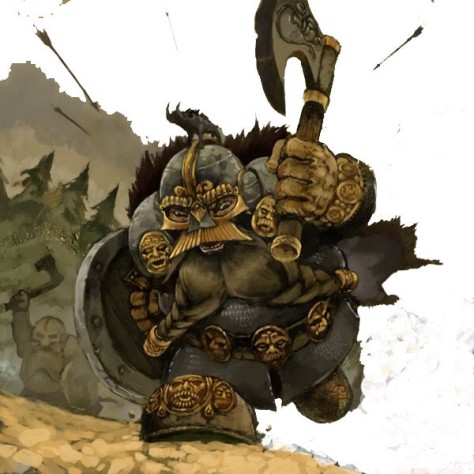
Gnomes
Gnomes didn’t have a lot of character under the old rules, being sort of like dwarves but not really, so I decided that they were the most magical of the “little people.” I reflected that in their class options, but for now, I’ll say that if you like spellcasting, a gnome is a solid way to go in my campaign.

Despite that, I think deep gnomes are a bit too magical (for example, being able to summon earth elementals at 6th level in any class except illusionist), so, yeah, no: I’m not allowing them. Preferred weapons for gnomes are daggers and darts, and they receive +1 “to hit” with both.
Halflings
As mentioned above, UA spends some time talking about the differences among Hairfoots, Stouts, and Tallfellows, but again, so what? A hobbit is a hobbit is a hobbit.
For several years in a previous campaign of mine, Jungle Guide Patrick Eibel played the best halfling character I’ve ever seen. Roary Tolman was a thief-acrobat who, with pluck and skill, rose from humble origins to eventually start and run his own thieves guild (as well as a flourishing vineyard and winery, his cover business).
Halflings are well-served by the PHB rules, so the only tweaking I did with them was to make daggers and slings their preferred weapon, giving them +1 “to hit” with both.
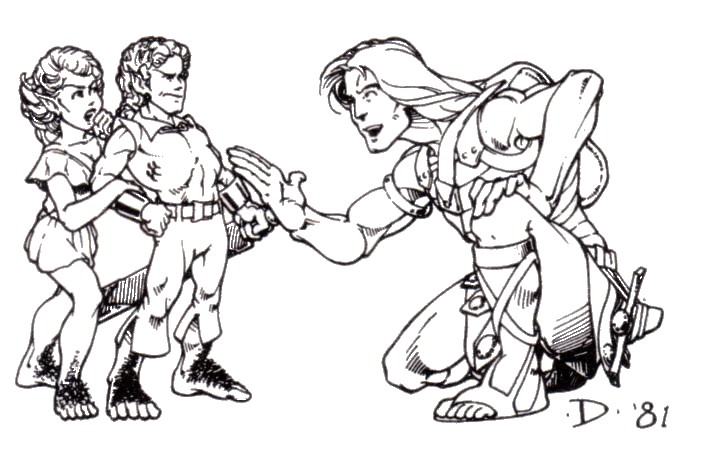
Where are the Half-Orcs?
Old-school veterans will note that I have conspicuously left off half-orcs, a playable race under the PHB and UA. That’s because I’ve never had anything but trouble from half-orcs and their players, for a variety of reasons.
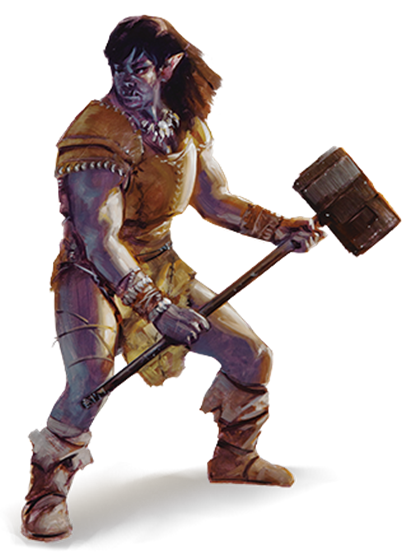
Over the years, many of my players have favored elves and half-elves, who don’t get along well with half-orcs (and vice versa, of course). Half-orcs usually have low Charisma scores, and the resulting conflicts between them and NPCs have frequently dragged the other PCs into thorny situations.
Worst of all, some of my gamers have viewed playing a half-orc as having a license to be a dick to the other players, particularly if the half-orc PC is also of evil alignment.
Intra-party strife is never a good thing, distracting from the game narrative, slowing down play, or even bringing it to a crashing halt while the other players do one or more of the following:
- Shift uncomfortably in their seats;
- Try to make peace;
- Tune out;
- Pick sides; or,
- Quit out of frustration with the drama.
The absolute nadir I’ve been involved with as a DM was when two of my players–one with a lawful evil half-orc cleric/assassin, the other with a chaotic good human dual-classed fighter/cleric–got so heated about the actions of the former that they almost had a fistfight right at the gaming table. Instead of that, their characters fought each other to the death, with the fighter/cleric prevailing.
That was an absolute shit show, but those two players had been butting heads for months, and once it blew up, there was no stopping it. Needless to say, the half-orc player was soon gone.
So, “no” to half-orcs, and while we’re at it, “no” to evil PCs. I’ve had several of both in my campaigns, and they’re not worth the hassle.
What About…?
If you’re familiar with 5e D&D, you’ll probably know that in addition to the races I’ve covered above, the current game also has two other: dragonborn, and tieflings.
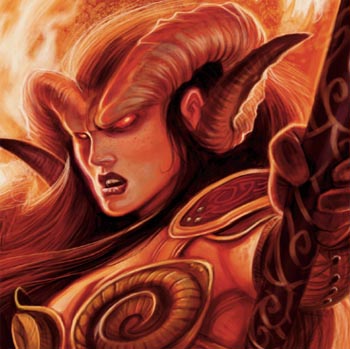
In the game’s earlier days, there were official or unofficial rules for several other races, such as aarakocra, centaurs, half-ogres, kenku, pixies, thri-kreen, “winged folk,” and many others.
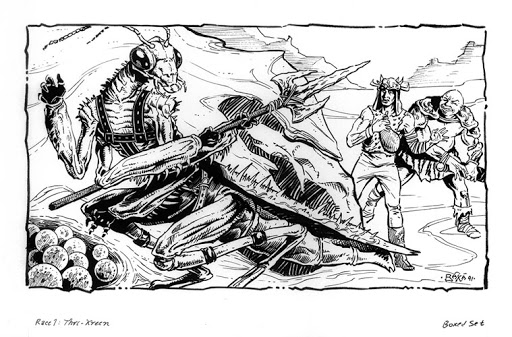
Some of my players ran them, and so did I, in the few times I’ve been a player and not a DM. One of my favorite characters, whom I’ve used in several campaigns, is a half-ogre named “Grunga.”
Be that as it may, though, I’m not using any of these races. Why not?
- They can be overpowered. Trust me when I tell you that when a pixie (whose kind are naturally invisible) decides to become an assassin (with the chance to insta-kill anyone she surprises), the first casualty is one’s campaign.
- They can be hard to role-play well. Anyone can play a human. Someone with some exposure to fantasy lit/movies can fairly easily pull off an elf, dwarf, or halfling. But a 7′ tall, six-limbed warrior insect? I’ve done it, but it’s not easy roleplaying it as more than a human in a bug costume.
- It gets weird fast. I’m a hardcore Tolkien fan–I studied him and his works in college–and my campaign world has a very Middle-Earth feel. None of these non-standard races mesh–or have ever meshed–well with it or the NPCs. To me, a party with lots of these PCs is a circus looking for a town to roll into. But YMMV: maybe they would fit better in a different milieu.
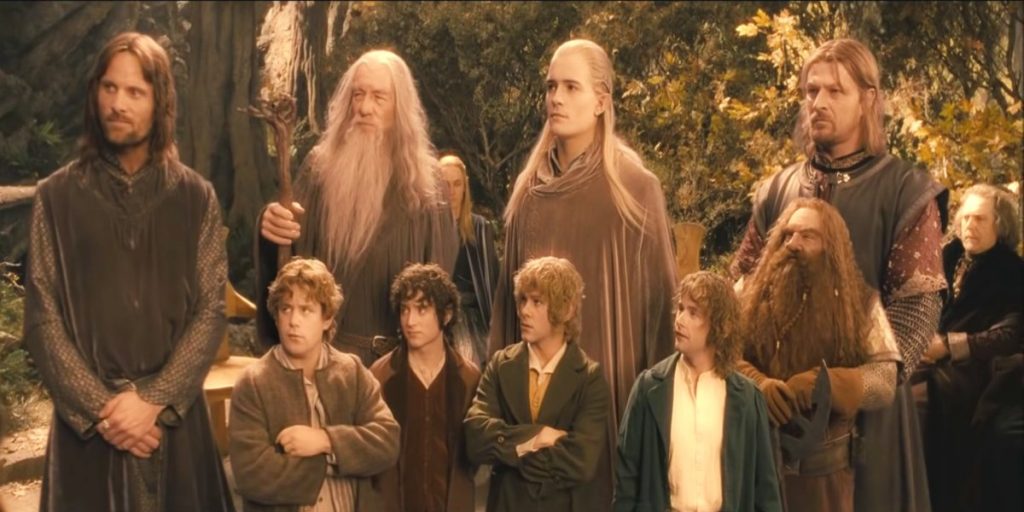
That’s enough for now: next time, I’ll talk about classes, including some surprising combinations.
Kenton Kilgore writes killer SF/F for young adults and adults who are still young. The Fighting Tigers of Veda appear in his latest novel, Stray Cats, which you can find here.
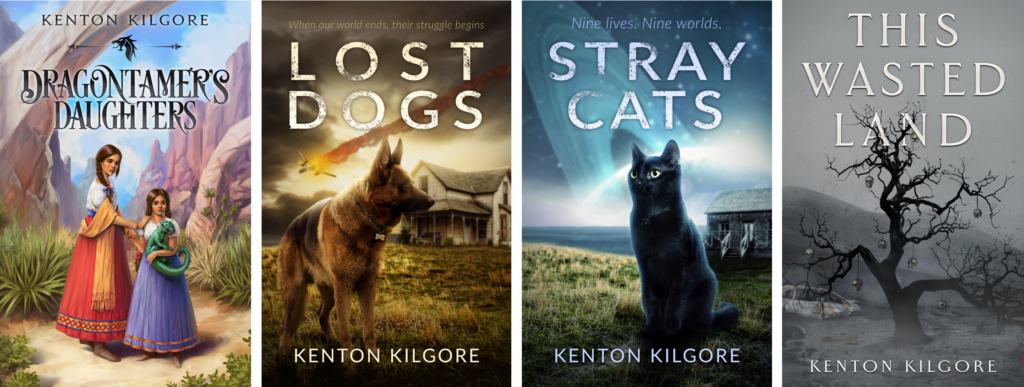
Check him out on kentonkilgore.com, and follow Kenton on Facebook for frequent posts on sci-fi, fantasy, and other speculative fiction. You can also catch him on Instagram, and find his books in softcover and for Kindle on Amazon.
